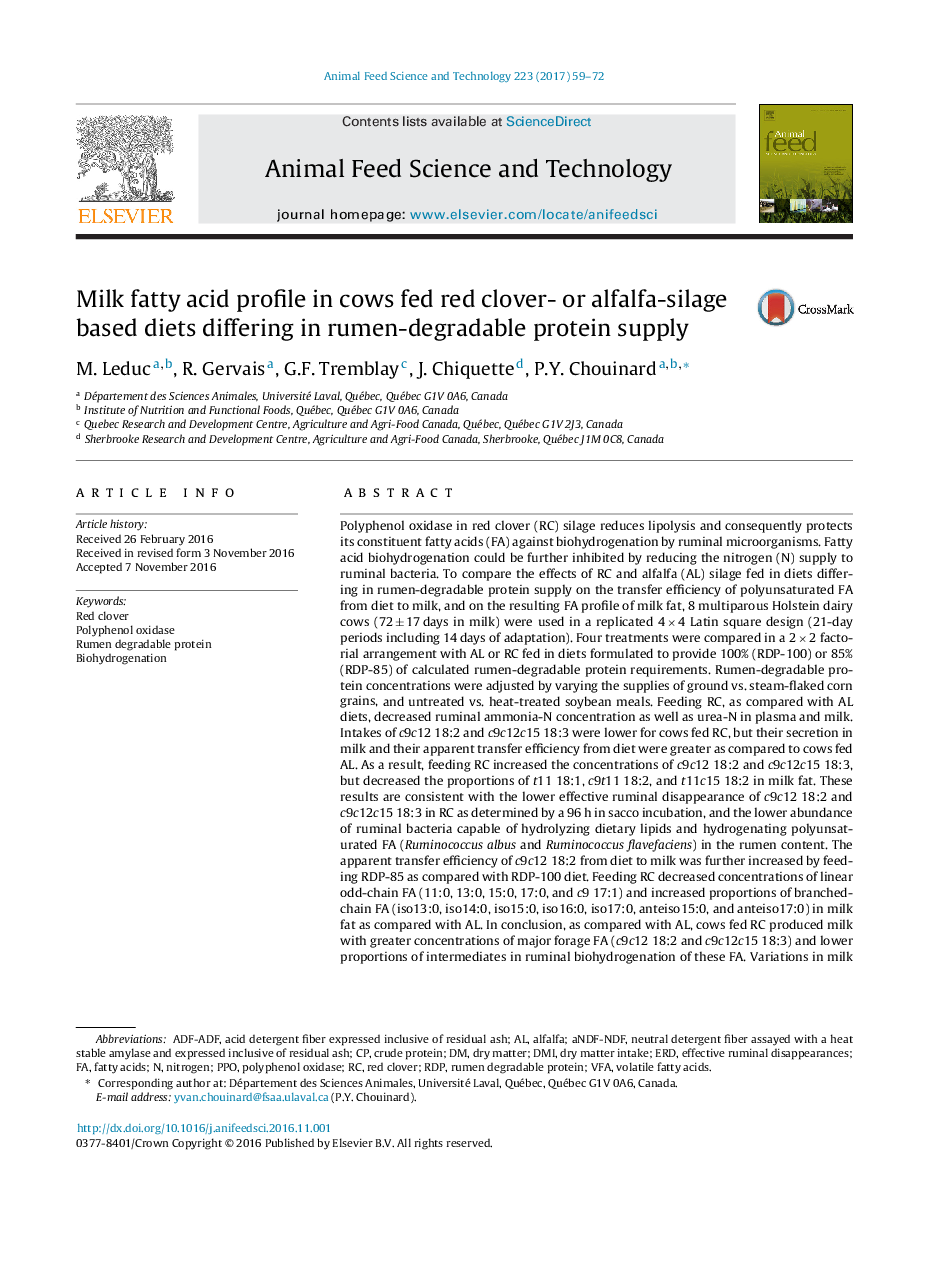| کد مقاله | کد نشریه | سال انتشار | مقاله انگلیسی | نسخه تمام متن |
|---|---|---|---|---|
| 5538866 | 1552363 | 2017 | 14 صفحه PDF | دانلود رایگان |
عنوان انگلیسی مقاله ISI
Milk fatty acid profile in cows fed red clover- or alfalfa-silage based diets differing in rumen-degradable protein supply
ترجمه فارسی عنوان
پروتئین اسید چرب شیر در گاوهایی که از رژیم های مبتنی بر خرچنگ قرمز یا یونجه و سیلیس استفاده می کنند، متفاوت از منبع پروتئین تجمع شکمبه هستند
دانلود مقاله + سفارش ترجمه
دانلود مقاله ISI انگلیسی
رایگان برای ایرانیان
کلمات کلیدی
DMIERDacid detergent fiber expressed inclusive of residual ash - الیاف پاک کننده اسید بیانگر شامل خاکستر باقی مانده استNeutral detergent fiber assayed with a heat stable amylase and expressed inclusive of residual ash - فیبر شوینده خنثی با آمیلاز پایدار حرارت داده شده و بیانگر شامل خاکستر باقی مانده استdry matter - ماده خشکdry matter intake - مصرف ماده خشکcrude protein - پروتئین خامAlfalfa - یونجه
موضوعات مرتبط
علوم زیستی و بیوفناوری
علوم کشاورزی و بیولوژیک
علوم دامی و جانورشناسی
چکیده انگلیسی
Polyphenol oxidase in red clover (RC) silage reduces lipolysis and consequently protects its constituent fatty acids (FA) against biohydrogenation by ruminal microorganisms. Fatty acid biohydrogenation could be further inhibited by reducing the nitrogen (N) supply to ruminal bacteria. To compare the effects of RC and alfalfa (AL) silage fed in diets differing in rumen-degradable protein supply on the transfer efficiency of polyunsaturated FA from diet to milk, and on the resulting FA profile of milk fat, 8 multiparous Holstein dairy cows (72 ± 17 days in milk) were used in a replicated 4 Ã 4 Latin square design (21-day periods including 14 days of adaptation). Four treatments were compared in a 2 Ã 2 factorial arrangement with AL or RC fed in diets formulated to provide 100% (RDPâ100) or 85% (RDPâ85) of calculated rumen-degradable protein requirements. Rumen-degradable protein concentrations were adjusted by varying the supplies of ground vs. steam-flaked corn grains, and untreated vs. heat-treated soybean meals. Feeding RC, as compared with AL diets, decreased ruminal ammonia-N concentration as well as urea-N in plasma and milk. Intakes of c9c12 18:2 and c9c12c15 18:3 were lower for cows fed RC, but their secretion in milk and their apparent transfer efficiency from diet were greater as compared to cows fed AL. As a result, feeding RC increased the concentrations of c9c12 18:2 and c9c12c15 18:3, but decreased the proportions of t11 18:1, c9t11 18:2, and t11c15 18:2 in milk fat. These results are consistent with the lower effective ruminal disappearance of c9c12 18:2 and c9c12c15 18:3 in RC as determined by a 96 h in sacco incubation, and the lower abundance of ruminal bacteria capable of hydrolyzing dietary lipids and hydrogenating polyunsaturated FA (Ruminococcus albus and Ruminococcus flavefaciens) in the rumen content. The apparent transfer efficiency of c9c12 18:2 from diet to milk was further increased by feeding RDPâ85 as compared with RDPâ100 diet. Feeding RC decreased concentrations of linear odd-chain FA (11:0, 13:0, 15:0, 17:0, and c9 17:1) and increased proportions of branched-chain FA (iso13:0, iso14:0, iso15:0, iso16:0, iso17:0, anteiso15:0, and anteiso17:0) in milk fat as compared with AL. In conclusion, as compared with AL, cows fed RC produced milk with greater concentrations of major forage FA (c9c12 18:2 and c9c12c15 18:3) and lower proportions of intermediates in ruminal biohydrogenation of these FA. Variations in milk fat concentrations of odd- and branched-chain FA, which are synthesized in the rumen by various microbial populations, may be reflecting the effects of forage source on ruminal fermentation.
ناشر
Database: Elsevier - ScienceDirect (ساینس دایرکت)
Journal: Animal Feed Science and Technology - Volume 223, January 2017, Pages 59-72
Journal: Animal Feed Science and Technology - Volume 223, January 2017, Pages 59-72
نویسندگان
M. Leduc, R. Gervais, G.F. Tremblay, J. Chiquette, P.Y. Chouinard,
